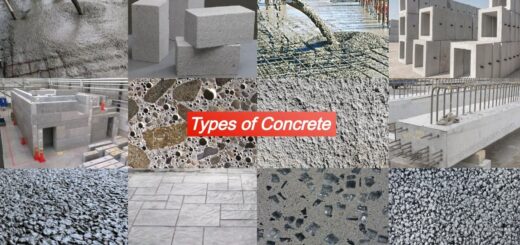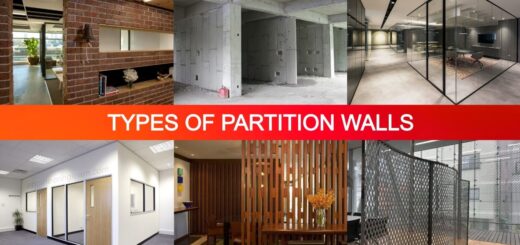9 Types of Stairs – Uses, Advantages & Disadvantages [with Pictures & Names]
![9 Types of Stairs - Uses, Advantages & Disadvantages [with Pictures & Names]](https://engineeringlearn.com/wp-content/uploads/2022/08/Stairs-1024x539.jpg)
Introduction
Types of Stairs – Uses, Advantages & Disadvantages [with Pictures & Names]: – A stair is a progression of steps organized in such a way as to connect various floors of a building. Stairs are designed to give as simple and quick access to various floors. Stairs are a fundamental part of any structure having multiple floors.
As a matter of fact, staircases and stairs have been around as long as humans. Stairs are a fundamental feature of any structure with multiple floors. We accept them as a way of moving from one level then onto the next without a thought. Nonetheless, for any building or renovating project, it’s vital to consciously consider the type of staircases that will be utilized.
Different Types of Stairs
Each type of stair accompanies benefits and hindrances. Below we talk about probably the most widely recognized types and forms of stairs to assist you with choosing the best kind of stair for your venture.
1. Straight Stairs: ( Types of Stairs )
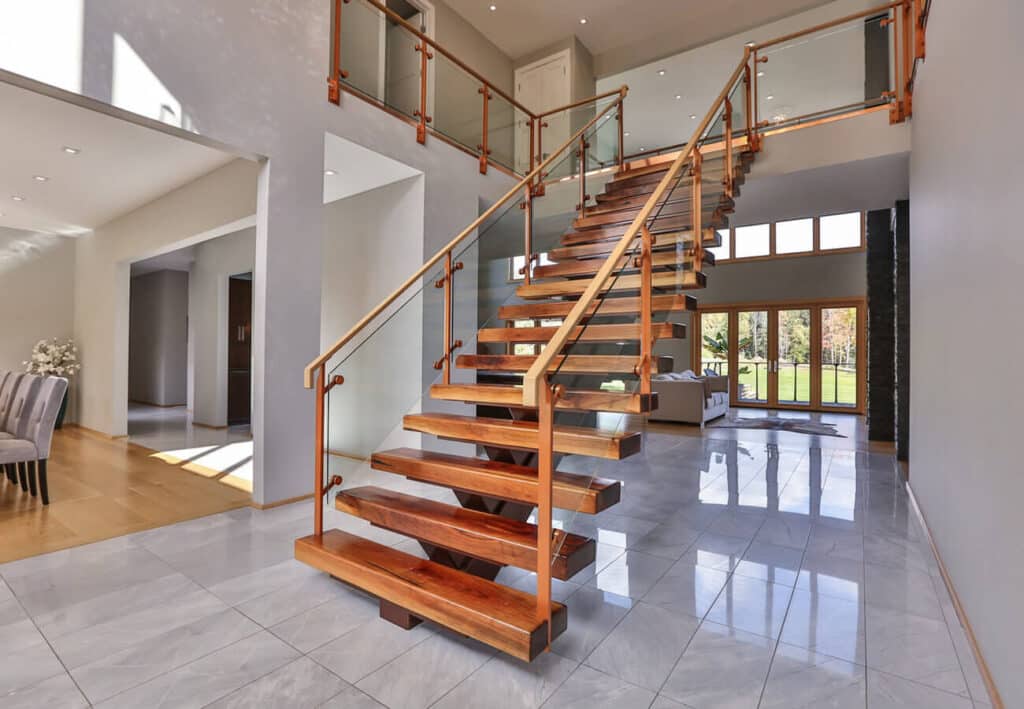
Straight Stairs are stairs with next to no changes in direction. They are unquestionably one of the most common types of stairs found in both residential and business properties. The following are instances of straight floating chars made with a variety of stringer styles, railing types, and wood species.
Each type of stair accompanies benefits and impediments. Below we talk about the benefits and hindrances of Straight Stairs
Advantages of Straight Stairs
- Straight steps will quite often be the easiest to go up and down, or, climb/plunge, as we say in the business.
- They are normally the easiest to construct, be that as it may, this relies a lot upon the level of detail in the design.
- Straight stairs just should be connected at the top and the base.
- They function admirably with moderately designed homes because of their inborn simplicity.
- By choosing more slender treads open risers, and thin metal stringers, straight Stairs can be made more transparent than other different kinds of stairs, permitting less obstruction to the view beyond.
- No landing is required assuming that the number of risers is kept under 16 or the general vertical level is less than 12 feet.
- Building railings and handrails for straight stairs is somewhat simple.
- Measuring or estimating railings for straight Stairs is less difficult than for other stair designs.
Disadvantages of Straight Stairs
- Straight stairs go through a decent measure of direct space, which must be anticipated in your design.
- A portion of the other stair types make a protection barrier between the floors of your home. Straight stairs don’t offer this privacy.
- The extension of a landing will use up, significantly more space, and consequently these types of stairs are just times used in residential construction. You will see these all the more frequently in large business structures.
2. Winder Stairs: ( Types of Stairs )
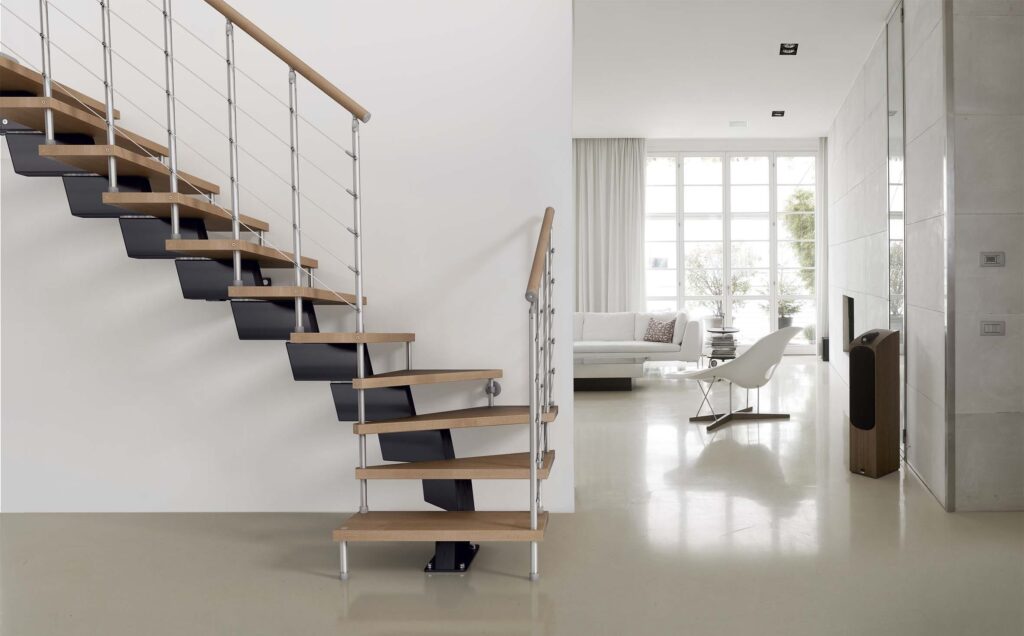
Winder stairs are a variation of a L shaped stair be that as it may, rather than a flat landing, they have pie-shaped or three-sided ventures at the corner transition.
Advantages of Winder Stairs
- The fundamental benefit of winder stairs is that they require less space than numerous types of stairs.
- They are extremely common in more seasoned homes and are frequently utilized as an optional staircase. For instance, they are common in homes where the grand staircase is in the doorway. In these cases, the winder stair is much of the time utilized as access to the kitchen.
- Winder stairs appear to make more consistent progress, visually, as they wander around corners.
- At last, they have acquired prevalence in modern homes. Their compactness has likewise made them alluring in sustainable home designs.
Disadvantages of Winder Stairs
- Winder stairs are somewhat harder to explore than L stairs.
- It very well may be more challenging to add a handrail to these than a portion of different types of stairs.
- Like with L shaped stairs center support is regularly required.
3. L-Shaped Stairs: ( Types of Stairs )
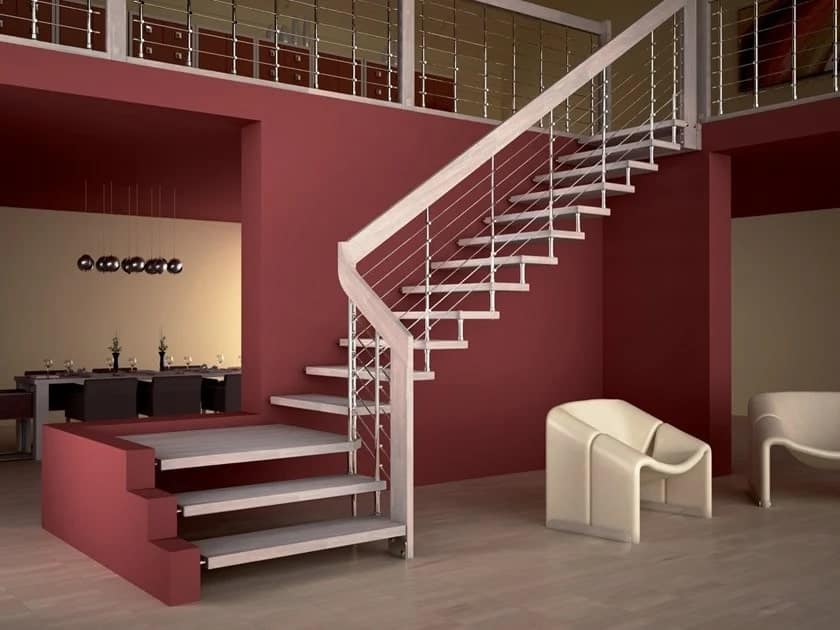
The L Shaped Stair is a variation of the straight stair with a curve in some parts of the stair. This curve is typically achieved by adding a landing at the transition point. The curve or bend is in many cases 90 degrees, nonetheless, it doesn’t need to be. On the off chance that the landing is closer to the top or bottom of the stairs, it is sometimes alluded to as a long L stair or a quarter turn stair.
Advantages of L-Shaped Stairs
- L-shaped stairs can be more visually or outwardly interesting.
- They give a visual barrier between floors in this way, they can add some security or privacy.
- L-shaped stairs can help fairly with sound transmission between floors assuming that the stairs are contained within walls.
- Some believe they are more secure than straight stairs as the central or focal landing lessens the number of treads one could fall in a given flight.
- The landing can provide a place to stop or pause and rest while ascending.
Disadvantages of L-Shaped Stairs
- A support is most often required for the landing in an L-type stair.
- Frequently, this is built into the surrounding walls, so it goes out of everyone’s notice.
- In present-day residences, it is usually alluring to open up the space by leaving the stair structure visible.
- In these cases, the supporting structure can be visually limited or minimized by taking advantage of the strength of steel to create slim supporting members.
- Handrails for these sorts of stairs require more skills or expertise and planning to construct than handrails for straight stairs.
- In climates where basements are utilized, stairs are regularly stacked over one another for productive utilization of space. Since basements are frequently utilized for storage, large items can be challenging or difficult to move all through the basement.
4. U-Shaped Stairs: ( Types of Stairs )
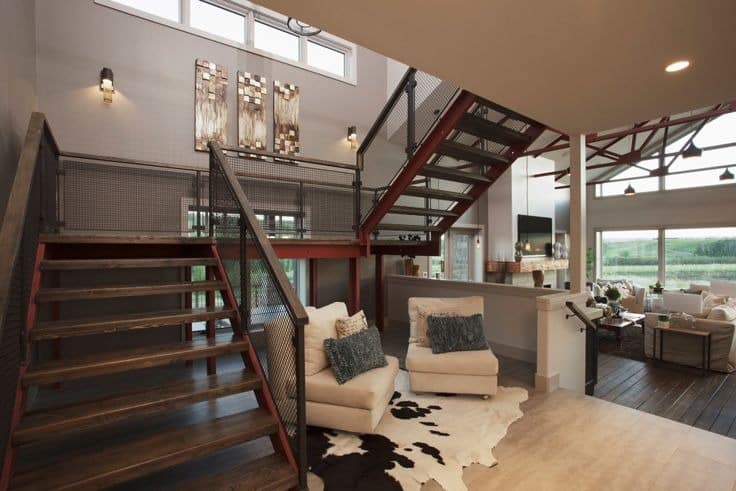
U-shaped stairs are basically two parallel flights of straight stairs joined by a landing that creates a 180-degree turn in the walk line.
Advantages of U-Shaped Stairs
- U shaped stairs can be easier to squeeze into an architectural plan.
- They offer some architectural interest.
- The landing(s) can offer a resting point somewhat up the stairs.
Disadvantages of U-Shaped Stairs
- These types of stairs are a bit more challenging to build than less difficult stair types.
5. Curved Stairs: ( Types of Stairs )
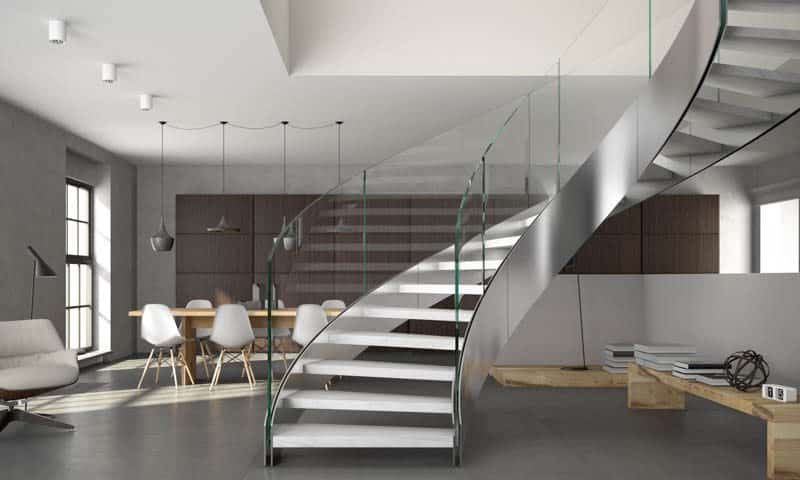
Like spiral stairs, curved stairs follow a helical curve. In any case, they will generally have a lot bigger range and regularly don’t make a full circle. Curved stairs add class to any home or business. Hence, they are quite often located at the entry where they establish the best first impression.
Advantages of Curved Stairs
- Curved stairs are frequently very elegant and conventional however this type of design can similarly be adjusted to contemporary architecture.
- They are moderately simple to walk up assuming the range is large.
Disadvantages of Curved Stairs
- Curved stairs are by far the most hard to build of the different types of stairs.
- As a matter of fact, building curved stairs addresses a zenith of accomplishment for any stair builder or fabricator. Consequently, they are the most costly to build.
6. Spiral Stairs: ( Types of Stairs )
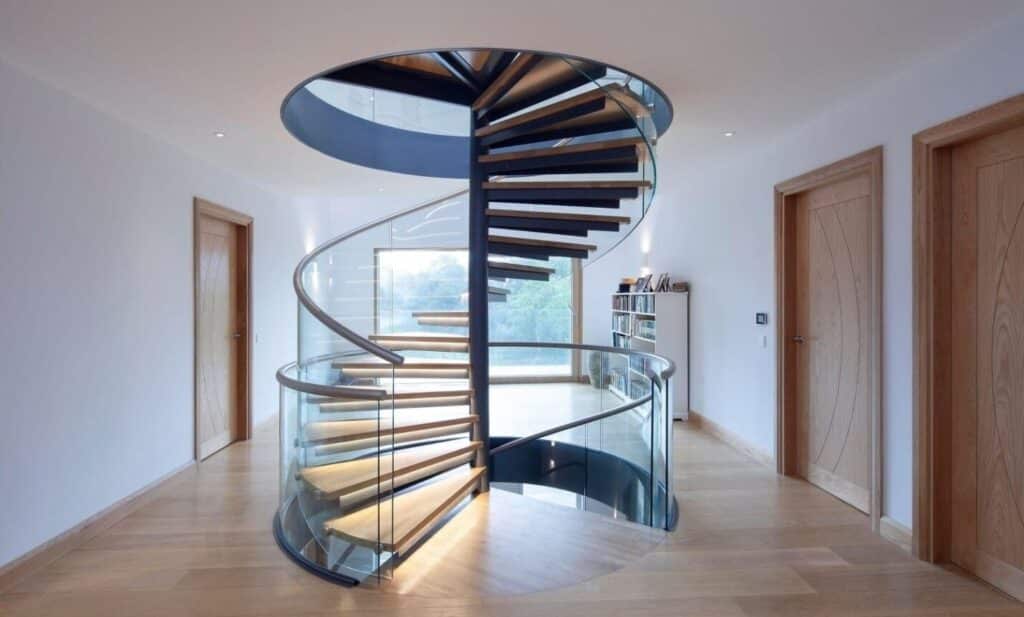
Spiral stairs follow a helical arc. They generally have an exceptionally compact design and the treads radiate around a central pole.
Advantages of Spiral Stairs
- One of the critical benefits of spiral stairs is their compactness.
- They are extremely popular on beachfront decks where space is along with some hidden costs. They are additionally utilized broadly on city lofts for a similar reason.
- Spiral stairs can be attractive and there are numerous variations in railings styles that can significantly affect the general appearance of the stair.
- Since the center pole and landing typically provide the structural support for the stairs, they don’t require a lot of that frame of mind of additional support structures, making installation simpler than with different types of stairs.
Disadvantages of Spiral Stairs
- Spiral stairs are more harder to explore than different kinds of stairs.
- It is hence that codes don’t permit them to be utilized as the essential admittance to an entire second floor of a home.
- Walkability improves as the outside diameter gets larger, so on the off chance that you have space, you might need to consider going a piece bigger.
- Carrying large things up spiral stairs is troublesome.
- Just a single individual can go up or down the stairs simultaneously.
7. Cantilever Stairs: ( Types of Stairs )
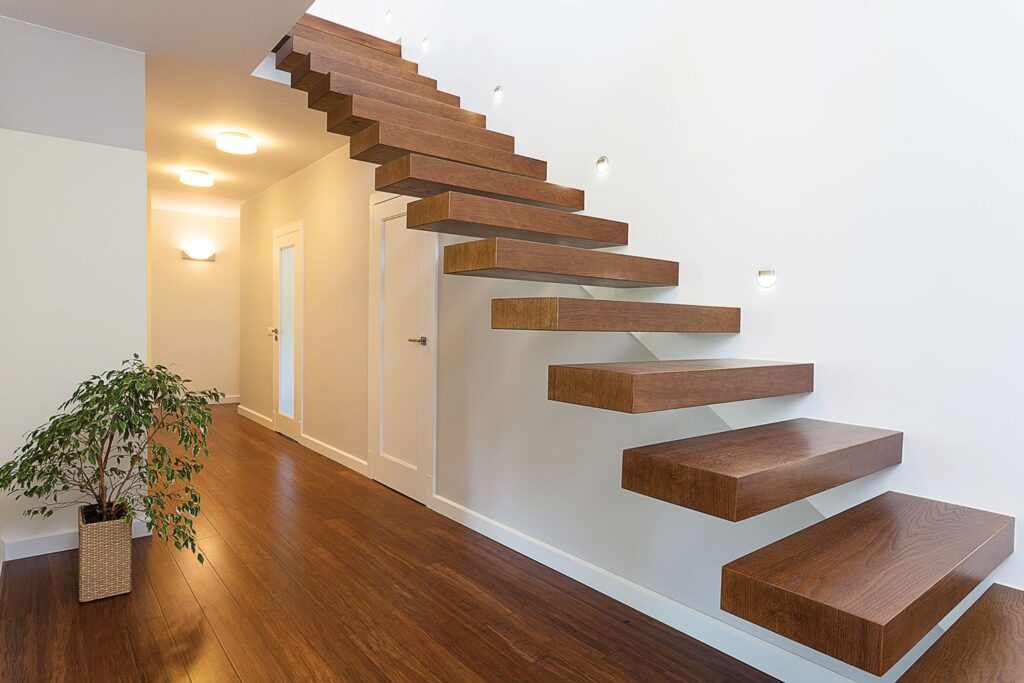
Cantilever stairs are made to have the stair treads appear to be floating in the air without support. The stair stringer will be attached to one end of the treads and can be covered up or uncovered. Cantilever steps or stairs add interest and extensive to any room of your home.
Advantages of Cantilever Stairs
- Cantilever stairs make more visual interest and are more unique than different types of stairs.
- The stringer is commonly located aside or hidden in the wall which can allow for more headroom.
- Cantilever stairs create a more open and extensive stylish in the room.
Disadvantages of Cantilever Stairs
- The design of the structure should be thought about to support the cantilever stairs.
- Treads upholds should be designed to deal with the weight and expected force.
- Cantilever stairs are more costly than an ordinary mono-stringer stairs because of extra structural requirements.
8. Split Staircase: ( Types of Stairs )
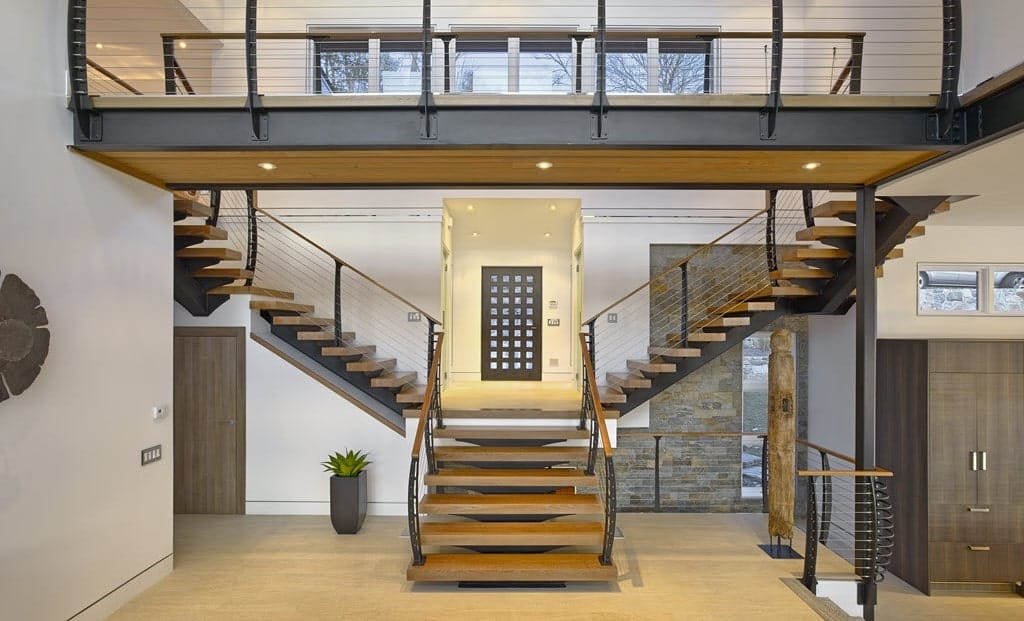
Split Stairs otherwise called bifurcated stairs normally have a wide set of stairs beginning at the bottom that closures to a landing partway up the flight. The stairs split at the landing into two smaller arrangements of stairs leading in inverse directions.
Advantages of Split Staircases
- Split stairs permit one staircase to work as two, by paving the way to various segments of the building making each end of the upper level effectively available.
- They add a noteworthy architectural design proclamation to the building.
- Regularly utilized in large homes or business structures as a Grand Entry.
- They are suitable for interior or exterior locations.
Disadvantages of Split Staircases
- Split stairs require a lot of space. This space requirement should be viewed in the design of the building.
- Split staircases is more costly than most stairs.
9. Ladders: ( Types of Stairs )
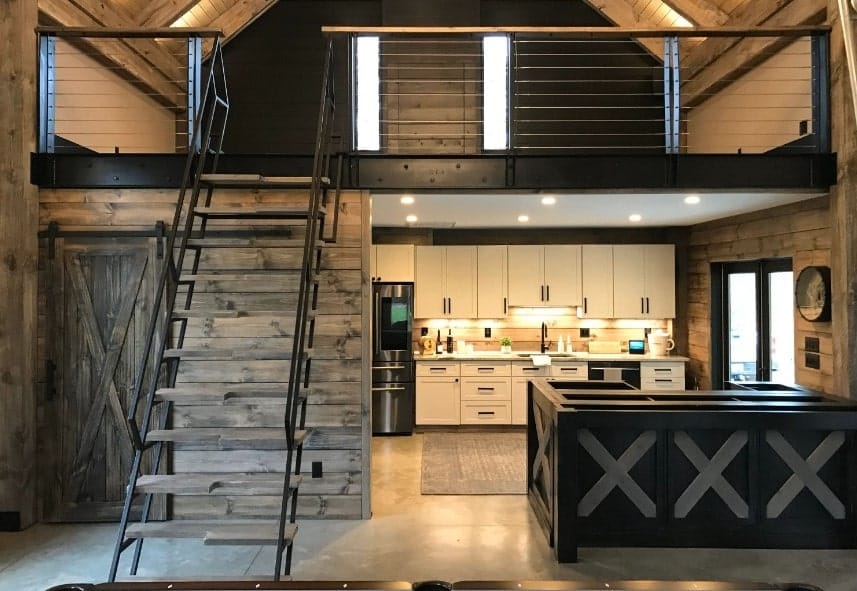
Ladders, similar to stairs, can serve as a mean of access. In any case, building codes don’t permit allow ladders to serve as an essential method for access.
Advantages of Ladders
- Ladders are the most compact method to get from one floor and then onto the next.
- They are extremely financially savvy because of their simpler design.
- Ladders might have wheels or fold up to move them far when not being used or to forestall access.
- They can be utilized to get access that would be excessively high to reach normally.
Disadvantages of Ladders
- Ladders are the most challenging to explore than stairs, particularly while descending.
- Ladders cannot be utilized as an essential staircase.
Conclusion
At the point when you consider the number of various types of stairs, alongside the variety of materials than can be utilized for the treads, risers, and railings, the potential outcomes are practically inestimable. One of the most important factors to consider while choosing a staircase style is the space required. The function, cost, and visual allure of the staircase additionally should be considered while choosing the ideal staircase design for your venture.

